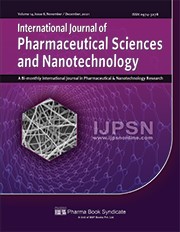Nanoliposomal Topical Formulation for Increasing Safety and Combating Microbial Drug Resistance in Leprosy
DOI:
https://doi.org/10.37285/ijpsn.2021.14.6.7Abstract
Nanoliposomes were prepared using solvent injection method and topical spray using simple dispersion method. The particle size and % Entrapment Efficiency were found 18.01 ± 0.21 nm and 87.71 ± 0.12% respectively. TEM studies showed that the particles were in spherical shape. Drying time, volume per spray, area of film and dose uniformity were found to be 280 ± 0.002 sec, 0.16± 0.021 ml, 155.57 ± 0.012 cm2 and 0.15± 0.0012 ml respectively which showed good spraying conditions on the affected area. Stability study shows that dapsone and chaulmoogra oil loaded nanoliposomal topical spray was stable at accelerated condition up to 1 month. The present investigation provides a safe approach by improving the outer membrane permeability to combat microbial drug resistance and increasing safety in leprosy treatment.
Downloads
Metrics
Keywords:
Dapsone, Chaulmoogra Oil, Topical spray, LyophilizationDownloads
Published
How to Cite
Issue
Section
References
AAH, A. (2016). ‘A Novel Topical Spray Formulation for Ginkgo Bioloba for Antifungal Activity’, Journal of Nanomedicine & Nanotechnology, 7(4). doi: 10.4172/2157-7439.1000386.
Chougule, M., Padhi, B. and Misra, A. (2008). ‘Development of spray dried liposomal dry powder inhaler of dapsone’, AAPS Pharm Sci Tech, 9(1): 47–53. doi: 10.1208/s12249-007-9024-6.
European Medicines Agency (2012). ‘Guideline on the Pharma-ceutical Quality of Inhalation and Nasal Products Draft’, (September), 1–15.
European Medicines Agency (2018). ‘Draft Guideline on quality and equivalence of topical products’, Ema/Chmp/Qwp/708282/2018, 44(October), 1–36.
F. Sforza, Milan, “Department of Internal Medicine, University of Milan”, Policlinico, Mangiagalli, Regina Elena Foundation IRCCS, Italy, 35.
Kan, P. et al. (2011). ‘A Liposomal Formulation Able to Incorporate a High Content of Paclitaxel and Exert Promising Anticancer Effect’, 2011. doi: 10.1155/2011/629234.
Lu, W. et al. (2013). ‘Preparation and characterization of a metered dose transdermal spray for testosterone’, Acta Pharmaceutica Sinica B. Elsevier, 3(6): 392–399. doi: 10.1016/j.apsb.2013. 10.003.
Ma, Y. et al. (2013). ‘Enhanced bactericidal potency of nanoliposomes by modification of the fusion activity between liposomes and bacterium’, 2351–2360.
Maherani, B. et al. (2011). Liposomes: A Review of Manufacturing Techniques and Targeting Strategies’, 436–452.
Mitkari, B. V et al. (2010). ‘Formulation and Evaluation of Topical Liposomal Gel for Fluconazole Formulation and Evaluation of Topical Liposomal Gel for Fluconazole’, (December).
Prathyusha, C. H. and Murthy, T. E. G. K. (2013). ‘Compatibility studies of Donepezil with different excipients by using HPLC and FTIR’, Journal of Advanced Pharmacy Education and Research, 3(3): 273–278.
Saingam, W. et al. (2018). ‘Thai Journal of Pharmaceutical Sciences (TJPS ), 42: 219–222.
Shaker, S., Gardouh, A. and Ghorab, M. (2017). ‘Factors affecting liposomes particle size prepared by ethanol injection method’, Research in Pharmaceutical Sciences, 12(5): 346–352. doi: 10.4103/1735-5362.213979.
Silva, A. C. et al. (2011). ‘Colloids and Surfaces B : Biointerfaces Preparation, characterization and biocompatibility studies on risperidone-loaded solid lipid nanoparticles (SLN): High pressure homogenization versus ultrasound’, Colloids and Surfaces B: Biointerfaces. Elsevier B.V., 86(1): 158–165. doi: 10.1016/j.colsurfb.2011.03.035.
Sulekha, B. and Avin, G. (2016). ‘Topical spray of silver sulfadiazine for wound healing’, Journal of Chemical and Pharmaceutical Research, 8(7): 492–498.
Suzuki, K. et al. (2012). ‘Current status of leprosy: Epidemiology , basic science and clinical perspectives’, (July 2011), 121–129. doi: 10.1111/j.1346-8138.2011.01370.x.
Tiwari, R. et al. (2018). ‘Development, Characterization and Transdermal Delivery of Dapsone and an Antibiotic Entrapped in Ethanolic Liposomal Gel for the Treatment of Lapromatous Leprosy’, The Open Nanomedicine Journal, 5(1): 1–15. doi: 10.2174/1875933501805010001.
WHO (2017). ‘Guidelines for the Diagnosis, Treatment and Prevention of Leprosy’, 1: 87.
Zhu, J. et al. (2018). ‘Preparation and characterization of norcantharidin liposomes modified with stearyl glycyrrhetinate’, Experimental and Therapeutic Medicine, 16(3): 1639–1646. doi: 10.3892/etm.2018.6416.






